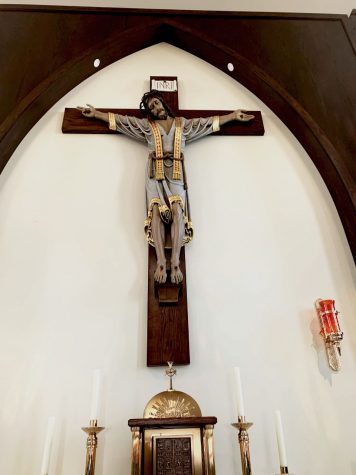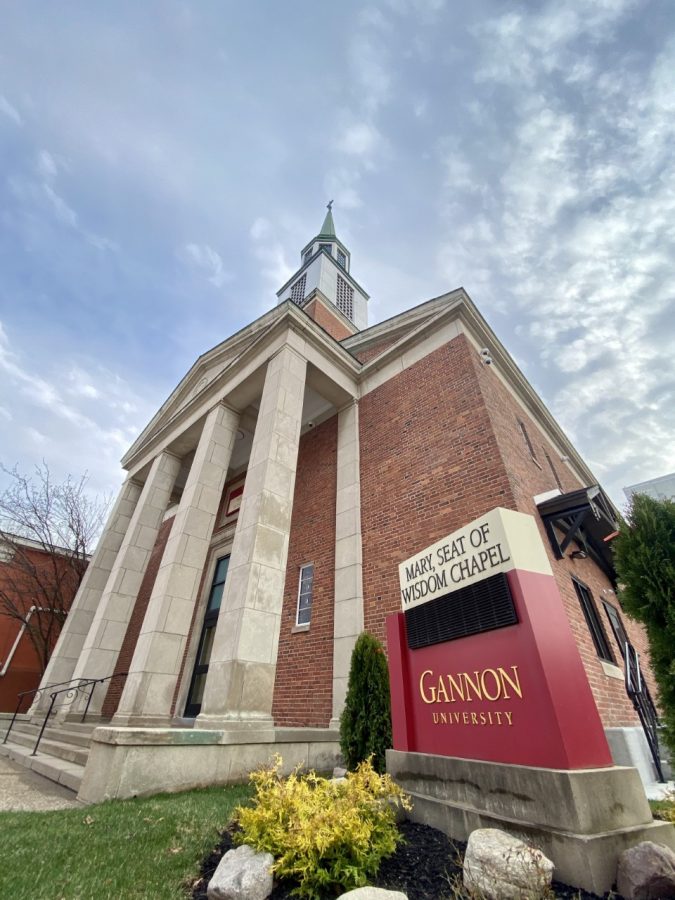Chapel renovations wrap up as semester comes to a close
After nearly two years of construction, chapel will open to students in coming weeks
Mary, Seat of Wisdom Chapel will reopen to students April 18.
April 6, 2021
Warmth. Grace. Beauty. All of these things can be felt upon walking into the newly renovated Mary, Seat of Wisdom Chapel on Gannon University’s campus.
The dark wood emits a sort of warmth that makes one feel welcome, regardless of religious background. The colored light from the stained-glass windows emits a feeling of peace. And, although it is only a few steps off Peach Street, the chapel seems to be of a different world, free of the clutter of sounds that make up downtown Erie.
Students will soon be able to seek peaceful refuge in the chapel, as the renovations on Gannon’s own place for worship are coming to a close after a long period of work that was only exacerbated by the COVID-19 pandemic.
After a dedication ceremony at 1 p.m. Sunday, April 18, the chapel will reopen to the Gannon community.
According to the Rev. Michael Kesicki, university chaplain and vice president for Mission and Ministry, the renovations have been a long time coming. Starting at the end of the fall 2019 semester, they were part of an effort to repair a gas leak that was discovered in the spring of that year.
The thought, Kesicki said, was that some damage had to be done to the chapel to reach the gas well, and the chapel itself hadn’t been renovated since it was acquired by Gannon in 1989. In a way, the structure was due for some updates. These updates, of course, were only made possible by donors.
“We had a major gift from Monsignor Robert Brugger,” Kesicki said. “He received something from his family that he wanted to hand over to Gannon. His was the lead gift, which then encouraged others to give, and a lot of alumni donated, too.”
Brugger graduated from Gannon in 1962 and was the pastor at St. Jude Catholic Church and St. George Catholic Church.
A campaign for donations was started in the late summer of 2019, headed by Almitra Clerkin, associate vice president for university advancement. Through her position, she was charged with organizing the campaign for the chapel, devising the communication plan to reach alumni, working with marketing to create the materials that were used and handling the donors.
“A lot of alumni wanted to support the chapel because of our Catholic tradition and mission,” Clerkin said.
Clerkin also said she and her team looked at past donors who donated in 1989 and 1993 and reached out to them to see if they were interested in contributing again. Then, alumni who could have been interested in donating for a variety of reasons, from being a member of the Catholic church to having participated in Campus Ministry as a student at Gannon, were contacted.
“All in all, everyone seemed to have a connection when they made their donation to the campaign,” she said.
Donations from alumni and previous donors started with the pews, which each cost $2,020. Next were the stations of the cross, which hang along the walls of the chapel. Kraus Hall, a room located at the back of the building, was made possible by Dr. Gerald Kraus and his wife, Anne Kraus, who made a $125,000 donation to turn what used to be the daily Mass chapel into a common area for students to gather.
“They wanted to make a donation in the name of his father, Dean Kraus,” Clerkin said. “Without him, we would not have an engineering program on our campus. So, this very faithful family wanted to do something in memory of him.”
Kraus Hall is located off the main chapel. According to Kesicki, the hall is a common area for students. Much like other group spaces on campus, it can be reserved for groups and is open to anyone who reserves it.
According to Brent Heckman, director of Campus Ministry, Kraus Hall was built to replace two community spaces that had been housed in the Pontifical Center, which was demolished to make way for construction equipment to access the gas well that was leaking. Dubbed the upper lounge and the lower lounge, they were spaces for students to host events, meetings and meals – especially Campus Ministry student groups.
“A lot of our Campus Ministry student groups will now meet in Kraus Hall throughout the week, and the space will be available for other groups to use for things like fellowship dinners,” Heckman said.
Having lost the space the lounges provided, Heckman said it’s nice to have a dedicated space connected to the chapel for Campus Ministry and others, as well.
“For us within Campus Ministry, I like the fact that we have a space where we can meet and do hospitality after Mass,” he said. “I think it will go a long way for us to really build a faith community on campus. Having a space connected to the chapel makes a lot of sense for us, and for others, too.”
The thought, Kesicki and Heckman said, is that it will be used for hospitality after Sunday Mass and that student groups can reserve it at any other time. However, they said that it shouldn’t be used for hour-long meetings, but more for meetings or events that last a few hours and in which people do things, like a short retreat for a sorority.
“We want to see situations in which people could actually make use of it,” Kesicki said.
The room features tables and chairs – both for functional purposes and comfortable purposes. In addition, two screens can be hooked up to like the ones in the study rooms in Nash Library.
“I think this space will be an excellent place for me and all Gannon students to gather in a community of faith, love and support,” said Sara Greb, a junior physician assistant major and Campus Ministry student leader.
In addition, mostly everything in the building is compliant with the Americans with Disabilities Act of 1990 (ADA). A wheelchair-accessible ramp leads from Kraus Hall into the main chapel, and the restrooms, confessional and devotional are all on the first level of the building.
The only part that isn’t ADA-compliant is the chapel balcony, which would require an elevator leading up to it in order to be compliant. As a result, the space can’t be designated for meetings or events, but students are welcome to climb the stairs to the space if they need somewhere quiet to think.
The features of the chapel itself aren’t unrecognizable from what they were prior to the renovations. In fact, many of them are the same, like the crucifix that hangs over the sanctuary, the place where the altar sits.
The figure of Jesus that is affixed on the crucifix is from the original chapel and was given to Gannon from a church in the Pittsburgh area in the 1990s. Originally, it had a cross behind it, but the wall at the time wasn’t strong enough to hold both Jesus and the cross, so it was decided that only Jesus would hang above the sanctuary. However, Kesicki said this caused some confusion.
“In my experience, I found that many students didn’t quite know why it was that way,” he said. “They knew it was Jesus, but they didn’t know why there was no cross.”
As part of the renovations, a wall that could withstand both a cross and the Jesus statue Gannon acquired in the 1990s was a priority.
The figure of Jesus was repainted by an artist in Pittsburgh, who painted it in a manner that would be found in European, especially German, churches, Kesicki said. It is painted in a manner that symbolizes Jesus’ priestly identity, as he is dressed in the robes of a priest before the priest has finished vesting. The image, called “Jesus the Priest,” includes a gold and red stole representing Jesus’ act of dying as a priestly act, Kesicki said, which members of the Gannon community can resonate with and connect back to Catholic teaching.
“Every Christian, by baptism, has a priestly identity,” he said. “A priest makes an offering to God on behalf of all of the people. Jesus made the offering of his life, so Christians are called to a priestly identity by the sense that our lives are given to us, and we’re called to offer them to other people in service.”

In addition to the crucifix, the stained-glass windows are original to the chapel. While some of them date back to when the First Presbyterian Church owned the building, others were installed in the 1990s, thanks to a generous donation by the Delta Sigma Phi fraternity. According to Kesicki, the decision to keep the windows was made immediately.
The altar, ambo, altar of repose and tabernacle also have symbolic meaning. On the front of each is carved a biblical scene or representation that relates back to the stories in the Bible.
On the front of the altar is the Last Supper, where the Mass was instituted.
On the front of the ambo, where the Word of God and scriptures are read, are symbols for the four Gospel writers – Matthew as an angel, Mark as a lion, Luke as a fox, and John as an eagle – all of which came from the prophet Ezekiel.
On the altar of repose, where the tabernacle rests, is the image of a lamb with a banner and the seven seals that come from the Book of Revelation, symbolizing Jesus as the victorious lamb and his body as the sacrifice.
Finally, on the tabernacle, where the Holy Eucharist is left in reserve, is a door that bears the same image as that of the Holy Door in St. Peter’s Basilica in Rome.
“We wanted to make sure there was unity here,” Kesicki said. “When we were trying to figure out what to get, a good friend and colleague of mine, the Rev. Shane Mathew, told me to get the tabernacle I wanted, then figure out the rest.
“So, we were looking through catalogs and pictures of what to get, and we knew we wanted this tabernacle. Then, we saw the other pieces and that they all came from the same company in North Dakota, and it all came together. We just kind of found them and they all fit.”
One of the big changes is that there are no longer just chairs for those who attend Mass or visit the chapel to sit in, but pews made of dark wood to match the rest of the wood in the chapel. This, and the color of wooden accents, contribute to the warm, homey feeling Kesicki hopes draws students into the space.
“We wanted this space to be beautiful, gracious and warm,” he said. “I always find that wood communicates a sense of warmth.”
While the space is precious in the sense that it is a dedicated religious and spiritual place, it is not so precious that students have to be timid and cautious when using it.
“We don’t want it to be so precious that students feel like they can’t come into it,” Kesicki said. “We want them to feel like they can.
“My hope is that when it is open, students are encouraged not only to sit and visit, but they can also quietly walk around and take a look.”
Making the chapel a spiritual home for students was much of the driving force behind the decisions made during the renovation process. Between the durable floors, the welcoming and warm wooden tones and the spaces designated for students to find peace, the space of worship looks like it will fulfill its purpose. Students involved in Campus Ministry feel that this will, indeed, be the case.
“While religious and spiritual experiences rely more on one’s internal environment and relationship with God, our physical environment helps us to connect to things beyond this world,” Justin Johnson, a senior social work and theology major and Campus Ministry intern, said. “I would love to just sit in the silence of the chapel or listen to music as a way of seeking peace from the stress of our world.”
After the April 18 dedication, the chapel will be open to the Gannon community, and Kesicki hopes that the Gannon community will seek out the space in the chapel as a sort of home away from home.
“It’s a spiritual home, and we haven’t had one, so I think it will improve students’ experience on two fronts,” Kesicki said. “First, as a place to have Mass and worship. Second, as a place where more students can know they can just go to and learn how to be silent before God. That’s my hope, that they would feel this is their place they can come to.
“That would be the most important thing I want to give to them – I want them to feel like this is a home for them.”
MADELINE BRUCE






